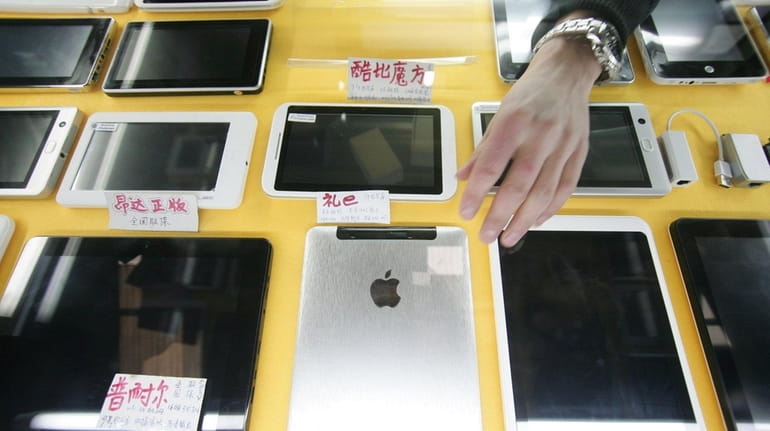Doing business globally? Protect your trademark overseas

Some iPad-like devices are displayed at a shop in Shanghai, China on March 4, 2012. Apple's troubles in China over the iPad trademark are not its first, and given its penchant for "iproducts" they are unlikely to be its last. Credit: AP
A trademark can be a company’s greatest asset.
It protects the name or symbol that customers have come to identify you with.
For many smaller companies, getting trademark protection in the U.S. may seem adequate, but with the Internet creating more global opportunities, companies should consider getting trademark protection overseas.
“Each country has its own individual trademark protection system, and protecting a trademark in the U.S. does not protect it anywhere else,” explains Stewart Bellus, senior trademark attorney at Collard & Roe, P.C., a Roslyn intellectual property law firm.
To be sure, only three or four decades ago most foreign trademark filings were made by major international companies because they were doing business overseas.
But today, especially with the Internet, “you can have customers anywhere so it’s more crucial than ever to do so,” notes Bellus.
With that in mind, you should file early and quickly, advises Pina Campagna, a partner at Carter, DeLuca, Farrell & Schmidt, LLP, a Melville intellectual property law firm.
In many countries outside the U.S., it’s a first-to-file system, meaning the first to file for trademark registration gets priority, she notes.
First-to-file mainly pertains to civil law countries like most of Asia and Western Europe, explains Kenneth L. Port, a trademark expert and professor of law at Mitchell Hamline School of Law in St. Paul, Minnesota.
In common law countries like Australia, the U.S. and Great Britain, trademark rights are based on first-to-use, meaning the first to use the trademark in the marketplace typically gets the rights going forward, he notes.
About two-thirds of the world’s population lives in civil law countries, “so if you want access to two-thirds of the world, you need to file,” says Port, who advises filing in countries you plan to do business in and those you imagine your product reaching.
If you don’t file, someone else may beat you to it, he notes.
Just recently, Apple made headlines when it lost a trademark case in China allowing a Beijing company to continue using IPHONE on its leather goods.
Apple reportedly had filed for a trademark protection under trademark class 9 (electrical and scientific apparatus) and the Beijing firm had filed under Class 18 (leather goods).
There are 45 classes in which you can file for a trademark, explains Dennis Prahl, a partner at Ladas & Parry LLP in Manhattan, an intellectual property law firm.
“Trademarks have to be able to coexist side by side in different classes,” he explains.
So you may want to file in more than one class depending on your goods or service, notes Prahl, husband of Newsday sportswriter Barbara Barker.
Apple in the meantime said in a company statement: “We intend to request a retrial with the Supreme People’s Court and will continue to vigorously protect our trademark rights.”
Getting involved in a trademark battle can be costly but that shouldn’t prevent you from filing, says Prahl.
Although there are no guarantees, more often than not when you file outside the U.S, there are generally no disputes or objections over the trademark use or registration, adds Bellus.
Still, before you file you should always conduct a search to make sure the trademark is not already in use, advises Prahl. There are public databases such as TMview, but it pays to get a professional search done, he notes.
If you decide to register your trademark internationally, you can do it through each individual country’s trademark office or target multiple countries via The Madrid Protocol or European Union Trade Mark, says Campagna. See inta.org/TrademarkBasics.
“If you’re going to file in at least three or more countries you should try to use the Madrid Protocol because that’s when it becomes more cost efficient,” she notes.
Calculating Costs:
It costs on average about $1,000 to $1,200 to file an international trademark in a single country outside the U.S. and there are about 180 countries a business can potentially can file in. That doesn’t take into account legal fees if the trademark is contested.
Source: Dennis Prahl
Urologist sexual abuse case ... Carcinogens found in West Islip ... Lab results for Bethpage park drums ... Rangers win game 2
